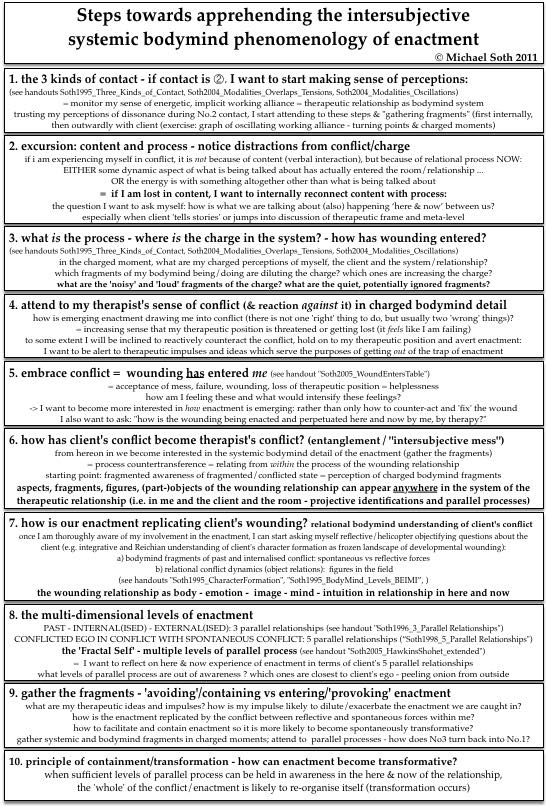A next-to incomprehensibly condensed summary from a recent workshop
I have been using the phrase 'gathering the fragments of the enactment' for many years, and many of you have asked me to give more detail - here finally is 'another fragment'.
I'm grateful to the students on my recent teaching touring in Pakistan, as well as all the tutors and assistants present, who helped me sharpen, simplify and clarify my attempts to formulate the bodymind phenomenology of enactment, and how - in the therapist's stream of consciousness - we try to catch our involvement in the enactment, by what I have been calling "gathering the fragments" (I wrote about this as a meta-principle for the first time in very abstract form in 2005 in the chapter on "Embodied countertransference", and have been experimenting with various formulations on "Steps towards apprehending the bodymind phenomenology of enactment" meant to be helpful in practice, in supervision and in the writing of session notes).
The conundrum of enactment as the paradoxical heart of therapeutic action, from a thoroughly two-person psychology perspective, requiring surrender to the vortex of enactment whilst maintaining a curious attentiveness and awareness to the here & now process of losing the therapeutic position and 'going down the plug-hole', has been described by the question/metaphor: how can the eye see itself?
Because being caught in the enactment structures our way of perceiving and looking and therefore how we 'see' the other through the lens of the enactment, through a looking glass darkly and opaquely, through our various affectively charged projections, transferences and countertransferences. We can know implicitly that we are caught in enactment, even when we are clueless as to what it is, and we can have a sense of its intensity long before we can formulate a reflexive thought or image. But we can surrender to our stream of consciousness with some degree of awareness, and perceive and 'catch' charged bodymind fragments, even as we are bewildered. The following are some comments written up from a part of the workshop where we focused on the 'gathering of the fragments'.
What does it mean: to gather the fragments of the enactment? What are the underlying principles of 'gathering the fragments'?
- it’s understood that the therapeutic relationship is a two-person system, so we gather fragments across all the multiple levels and bodymind processes - all the multi-dimensional processes within each and between the two - of both the two people involved, client AND therapist
- one of the most basic understandings from the body-oriented tradition is the importance of spontaneous and emergent processes in the 'here and now' - many of these we can consider pre-verbal, non-verbal and subliminal manifestations of the amorphous notion of unconscious processes. The unconscious manifests in tangible, subtle but observable 'here & now' relational processes, which are involuntary and happen - and keep happening - in spite of conscious control, voluntarily intentions and habitual defence mechanisms
- neuroscience has given us some validation for this pre-reflexive level of intersubjective understanding between humans, in the theory of mirror neurons or - in its recent form - the notion of ‘embodied simulation’ (which basically says that we use our bodies to simulate what we perceive - via our mirror neurons - to be the internal state of the other, without having to think about them, speculate mentally or any need to have a 'theory of mind' - search Vittorio Gallese); this automatic, body-to-body mutual understanding - sometimes equated with implicit relational knowing - goes much further than most psychotherapy of the last hundred years has imagined (except for Wilhelm Reich's idea of vegetative identification)
- the practical upshot of this is that when we 'gather the fragments', we intuit each fragment as belonging either into the category of spontaneous or reflective fragments; we do not need to categorise them consciously, we intuitively know: spontaneous bodymind fragments emerge without bidding, in spite of voluntary control - they are ‘happenings’ rather than ‘doings’, ‘intendings’ or ‘thinkings’
- in the olden days, we used to think that these spontaneous bodymind fragments are all coming from the body, but this is a very misleading oversimplification: there are spontaneous body processes like shaking, trembling, sudden breaths or gestures, twitches, jerks and other movements, involuntary flushes or gasps; but there are also other spontaneous processes not in the body, but in the mind, like spontaneous images and metaphors, melodies or thoughts which come unbidden, Freudian slips of the tongue, and all the non-verbal messages of the voice apart from the words
- reflective fragments are all those bodymind processes which counter or inhibit or override spontaneous processes (whether these manifest in the body or in the mind or both), whether they manifest spontaneously or habitually (the fact that reflective processes can manifest spontaneously already indicates their fundamentally paradoxical nature – so these binary distinctions will break down the more we get into the nitty-gritty of experienence); reflective then refers to the reflective capacities of the mind, but reflection also includes the Gestalt idea of retroflection as a bodily process of inhibition, or Reich’s idea of the ‘turning against the self’ as a habitually repeating and re-enacted process of character formation
- from developmental psychology we understand that the client’s experience carries habitual embodied conflict (developmental wounding and deficiency due to character formation and the ‘turning against the self’) – this manifests in chronic implicit conflict across all aspects of the client’s bodymind system (i.e. embodied character style = developmental injury frozen into the bodymind; biographical psychology fixated in biology); in simple terms: chronic conflict between ‘habitual mode’ and ‘emergency’ (see hand-out: The Client’s Conflict between ‘Habitual Mode’ and ‘Emergency’ (2015))
- the defensive ego system is trapped in a habit of constantly fighting and counteracting the wounding inherent in the ‘emergency’; this is rooted in the origin of the ego’s defensive script: “I will do whatever I can to prevent that kind of wounding ever happening again – I will control things so I will never ever have to experience that again!”
- the wounding inherent in the ‘emergency’ has a tendency towards spontaneous ‘coherence’: like any unfinished cycle, it wants to come to the foreground so it can be re-experienced and be healed by finding a different, more satisfying outcome: the wounding can be experienced and held and healed, if all the fragments of the conflict can be momentarily held in ‘coherence’, the person then feels – at least temporarily – more ‘whole’. Wholeness is the full bodymind experience of coherence, and constitutes the transcendence of chronic defensiveness and conflict - even if it only lasts a second, it means the categorical either-or all-or-nothing rigidity of the defensive system is broken (and if it can happen for a second, it can happen again and for longer - uncertainty has broken through and broken the rigid implicit 'rules' of the habitual mode’s defensive logic)
- the way the defensive ego system keeps the wounding at bay is by constantly counter-acting and fragmenting the tendency towards ‘coherence’; by constantly re-interrupting the emerging cycles towards coherence and re-enacting the wounding all over again, by denying, suppressing and keeping the fragments of the wounding experience fragmented, so they don’t emerge and cohere into awareness - paradoxically, by keeping the ‘emergency’ at bay, the wounding isconstantly being re-enacted
- traditional body-oriented theories oversimplified the chronic conflict between ‘habitual mode’ and ‘emergency’: the inhibiting defensive ego was conceptualised as repressing the spontaneous, expressive feeling of the body (life force), by equating 'the mind' with repression and equating 'the body' with aliveness = this is the traditional notion of the Body Psychotherapy's 'body-mind split' (as a manifestation of Cartesian dualism, or what Wilber calls ‘European Split’)
- this over-simplification of the 'body-mind split' – although is has a lot of truth to it – becomes unhelpful in practice; the fallacy is easy to see: there is spontaneity in the mind and there is reflection/inhibition in the body. The conflict does manifest between mind and body, but it also manifests within the mind (between different aspects of the mind), and it also manifests within the body (between different aspects of the body).
- in order to avoid the trap of that over-simplification, we need a more complex formulation: the conflicted ego in conflict with a spontaneous conflict;
- this notion does retain the mind-over-body conflict: the reflective ego is in conflict with spontaneous forces, battling against them and keeping them at bay
- but the new formulation means we do not imagine the ego as one entity (like a defensive castle); we do not imagine the body as one simple impulse or feeling; both sides of the wounding relationship inherent in the ‘emergency’ are embodied as a conflict; we imagine the ego itself as split and conflicted (building on Fairbairn’s theory: 'libidinal' versus 'anti-libidinal' parts of the ego)
- Fairbairn was in a philosophical battle against Freud’s drive theory, and wanted to establish the essential human nature as relational (object-seeking versus drive theory): by minimising the influence of biological drives, he wanted to emphasise the wounding of the human connection at the root of character formation; however, in the process he lost the ‘Id’ and the body, and located the conflict only in the ego
- the idea of the conflicted ego in conflict with a spontaneous conflict combines Fairbairn’s object relations with Reich’s holistic character formation
- it’s a simplistic summary, but usually one part of the ego champions the wounded child and the other part of the ego champions the wounding object; or we could say: the ego is a parallel process to the wounding inherent in the ‘emergency’ – the ego replicates the wounding relationship, with both people in the wounding relationship represented by the opposing parts of the ego (which is what Fairbairn was trying to get at by calling them 'libidinal' versus 'anti-libidinal')
- the fragmented ego is a fragmenting mechanism that maintains fragmentation and aborts potential emergent wholeness, in the process of habitually aborting the wounding inherent in the ‘emergency’ (the ego is fragmented and the ego operates to keep fragmenting the rest of experience which is already fragmented spontaneously)
- so in recognition of the fragmentation of the ego itself and its fragmentation strategies against bodymind coherence, gathering the fragments is basically an invitation: “I am here with you, to bear with you the experience of the wounding in whatever way it shows up here and now (and/or to participate in the always possible transcendence/transformation of the wounding).”
- the key principle of transformation: transformation of the wounding enactment becomes more likely the more fragments can be gathered in awareness across the multi-dimensional system of the therapeutic relationship - 'gathering the fragments' can engender a critical mass of coherence and transformation can then occur spontaneously (a slow steady accumulation of small incremental changes leading to a tipping point of large-scale changes, as in chaos and complexity theory = 'butterfly effect')
- there are many, many fragments, manifesting across many dimensions and many levels of parallel process, in two broad categories: bodymind fragments and relational fragments (i.e. figures/characters in the field)
- a simple summary would be: gathering the fragments involves sensations-emotions-breath-images-thoughts-intuitions in the 'here & now' of the therapeutic relationship (where 'relationship' implies the 3 parallel relationships (past, internal, present), each manifesting the 5 steps of character formation, comprising the whole configuration of multiple characters)
- an important idea here is the holographic principle: every part contains the whole image = every fragment contains the whole story – by attending to the detail of one fragment, the whole story of the enactment scenario can unfold (e.g. the process and structure of a hand movement contains the whole story of trauma, including the wounded child and the internalised abuser and the wounded child’s attempts to protect against it = every time we attend to a charged fragment, the whole wounding experience is embedded within it; gathering the fragments would need to include, for example, the shaking of the girl as part of biological-organismic recovery from trauma)
- in contrast to this multi-dimensional, embodied, parallel process, holographic/fractal understanding, traditional Eurocentric talking therapy is so diminished and partial in its philosophy, perception, understanding/theory and intervention/technique – it can only gather some of the levels and some of the fragments some of the time haphazardly, and therefore makes a full bodymind transformative experience unlikely; therefore, the traditional approaches can only approximate transformation – it needs an embodied, integrative, integral-relational approach to enactment in order to maximise our gathering of the fragments across all levels (philosophy/meta-psychology, perception, understanding/theory and intervention/technique as well as relational stance)
- gathering of the fragments is a co-created, intersubjective two-person bodymind process (as opposed to a one-person psychology stance where the therapist has all the perceptions and interpretive understandings and just passes these on to the client via interpretation or education; the client’s capacity to receive explanations and interpretations within the enactment is limited, as usually they feed the enactment – this kind of psycho-education is usually unavailable within the enactment due to regression and defences; it may be possible in degrees depending on whether the client’s mind is able to think dissociatively)
- from our side as therapists, in order to maximise gathering of the fragments we need full embodied awareness (so we do not by default exclude all the most important spontaneous fragments) AND relational flexibility (so we don’t get stuck and identified with fixed roles within the enactment) - flexibility around relational stance and modality always already implies equivalent flexibilities across all other levels (philosophy/meta-psychology, perception, theory and technique)
- from the therapist's side, different interventions could come from each and all of the modalities, i.e. the same or similar intervention could be made from multiple stances, as the dialogical cousin, the doctor, the evacuated child, the fairy god parent, the bad object step parent, the working partner collaborator, etc; and from the client's side, every therapeutic intervention can be perceived (or mis-perceived) as coming from each and all of the modalities
- psychotherapy integration on the level of relational modalities means we need to be flexible between them and – whatever our therapeutic intention or intervention – we want to be aware of how every therapeutic intention or intervention, from whatever modality, can become a vehicle for further enactment (even when our intervention is meant to simply invite a ‘gathering of the fragments’, it is still likely to fall into and exacerbate enactment)
- in order to help us with this flexibility between relational modalities, we can expand and extend Petruska Clarkson's original idea of the relational modalities into what I have called the 'Diamond Model of relational modalities' (which goes further and makes several significant adjustments and enhancements to Clarkson's model)
- the key principle is that any therapeutic intervention from each and any of the modalities can appear well-intentioned, effective, therapeutically justified and ‘helpful’, but can constitute another enactment (from within each and every modality), so we want to keep tracking the actual effect on the system (increase or decrease in charge), rather than make assumptions
A complementary blog post, addressing similar topics more generally, can be found here:
How is Countertransferential Enactment Worked Through? - Steps towards an embodied-relational answer
From: Daughters of Copper Woman ~ Anne Cameron
The phrase 'gathering the fragments' did not fall out of the sky - like all precious ideas it has a genealogy of elders, in this case, it is derived from the following song, from a book I read in the late 1980's "Daughters of Copper Woman" by Anne Cameron.
WEAVE AND MEND
Old Woman is watching, watching over you.
In the darkness of the storm she is watching.
She is weaving, mending, gathering the fragments.
She is watching over you.
Old Woman is weaving, gathering the threads.
Her bones become the loom she is weaving.
She is watching, weaving, gathering the colors.
She is watching over you.
For years I’ve been watching, waiting for Old Woman,
Feeling lost and so alone, I’ve been watching.
Now I find her, weaving, gathering the colors.
Now I find her in myself
Chorus: So weave and mend, weave and mend.
Gather the fragments safe within the sacred circle.
Sisters, weave and mend, weave and mend.
Old woman, weave and mend.
Clarification Questions
• to begin with, the enactment is largely unconscious; definitely for the client, but usually in large degrees also for the therapist - so how do we become conscious of the unconscious? How do we bring awareness to what is outside awareness?• I use the term ‘fragments’, because (as it says in the blog post):
- the fragmented ego is a fragmenting mechanism that maintains fragmentation and aborts potential emergent wholeness, in the process of habitually aborting the wounding inherent in the ‘emergency’ (the ego is fragmented and the ego operates to keep fragmenting the rest of experience which is already fragmented spontaneously)
• the way character defences work in bodymind terms is by fragmenting what might otherwise be a more whole, coherent and comprehensive experience - subjectively, rather than experiencing myself as a whole in a particular body-mind-psyche-feeling state, my experience is split into fragments, with some of these fragments repressed and dissociated, i.e. inaccessible to my awareness and therefore unconscious. That’s the whole point of defences, in simple terms: that I don’t get to fully feel what I’m actually feeling• rather than having a ‘whole’ bodymind experience, in which my body sensations, my emotions, my imaginative mind and my reflective mind all cohere together, I am landed with a collection of fragments, some of which I am aware of, some of which I can become aware of and some of which I’m habitually unaware (roughly equivalent to Freud’s distinction between conscious - pre-conscious and unconscious)• so that fragmentation of experience applies to both the two people’s psychology involved in therapy: client and therapist; each of them is only partially aware of themselves and of the other, i.e. they only have awareness in the stream of consciousness of fragments of themselves and of the other• enactments occur outside awareness between these two wounded and defended fragmented people, and have the power to draw awareness to the fragmentation with its inherent wandering which can thus potentially become transformed through enactment - i.e. fragmented states can transform into a sense of wholeness through becoming aware of enactments ( so rather than Freud’s “where Id was there Ego shall be” = making the unconscious conscious, we are formulating it as a two-person psychology process where it’s not just the client who is unconscious and not just the therapist who makes things conscious• as I said above: if both people are in degrees unconscious, and are both unconsciously perpetuating enactment and caught in it, gathering the fragments is - simply - about bringing awareness to the enactment• in this process, one of the most difficult and complex questions is the role of the body and the mind (or better: the relationship between spontaneous processes and reflective processes) and what the mind can contribute to gathering the fragments (taking into account that historically the assumption was that it is purely the conscious/rational mind that does make things conscious and makes meaning, by reflecting on bodymind experience - but that dualistic assumption doesn’t work very well)• so then we need to pay attention to how the ego-mind is involved in the therapeutic relationship (both the client’s and therapist’s), taking into account that the original function of the defensive ego is to avoid and defend against pain, by keeping experience fragmented - so how does a defended ego ever become conscious and gather the fragments of enactment? It goes against the grain of the defended ego to experience wholeness, because wholeness would include the wounding, and the purpose of the defended ego is to avoid the wounding (both the client’s and therapist’s)






Leave A Comment
You must be logged in to post a comment.